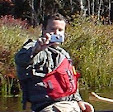Over the years I’ve heard people talk about leaning/healing/edging to the outside of a turn, but I never really knew what they were talking about. In whitewater paddling (canoe or kayak) leaning to the outside of the turn is a great way to end up in the drink – at least when crossing eddy lines. There is a freestyle canoeing move called a post that involves an outside edge heal, but I didn’t think that it was any more effective than its inside edge counterpart the axle, so I rarely did it. Like the bow pry/jam, it was something that I practiced, but didn’t really use in my day-to-day paddling. The only time I ever use an outside edge heal in my canoe is for a sideslip with a sculling draw.
After being out in the Capella a couple of times, I now know what they mean by edging to the outside of the turn. This boat absolutely responds to an outside edge heal. Raise the thigh and butt to the side that you want to turn (or drop the outside edge) and the boat will gradually turn in that direction. Add a forward sweep and the boat turns faster. Adjust the edging while paddling forward and you can make subtle turns without resorting to correction stokes.
Why does this work in a sea kayak? Sea kayaks are displacement hulls. Edging the boat changes the hull profile, releasing the stems, and moving the boat into an outside edge turn. Leaning slightly forward engages the bow in a carve and allows the stern to skid through the turn. It might have worked in my canoes if I gave it a chance, but the effect is much more pronounced in the Capella.
I went back to Lincoln Woods to practice some more outside edge turns. Before going I had practiced using the paddled as a brace on shore while getting in and getting out of the boat, and I was much more stable on the water. I set up the camera to do some off side edge circles. My edging technique needs work (I think the pegs are still too loose), but the boat definitely turns. There were times when I had locked in a good off side edge and I could feel the stern skidding through the turn. I also did some shoreline paddling using only forward strokes and outside edge turns to follow the shoreline.
I still get confused about which way to edge – raise the side in the direction that you want to go seems to be the easiest for me to remember. Its definitely not intuitive yet, and is the exact opposite of what I have always done, but I’ll get there eventually. Hopefully I won’t screw-up my whitewater boating in the process.





















